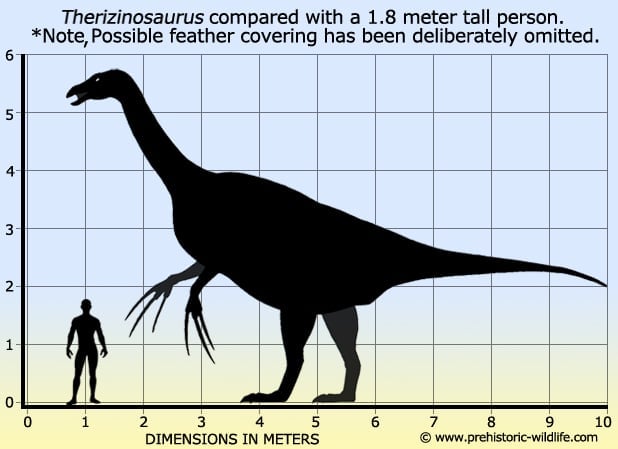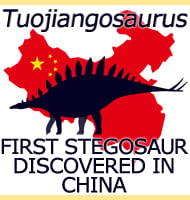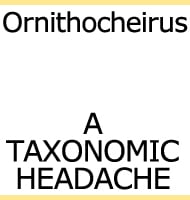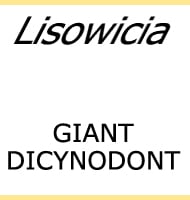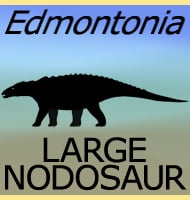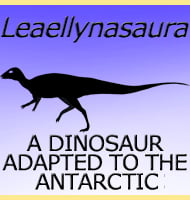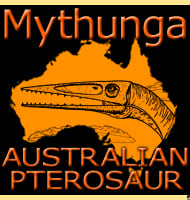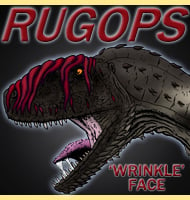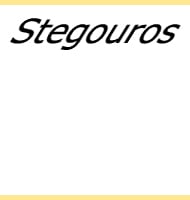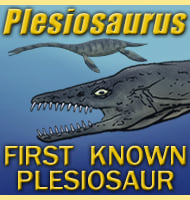In Depth
What makes Therizinosaurus and others from its group stand out from other dinosaurs are the huge claws that are on the end of its fingers. In Therizinosaurus these claws reached up to one meter long, and there purpose has three main theories. The first is for display, with the larger claws being indicative of reproductive maturity. The second theory which leads on from the first is for inter species combat between two males, in a similar manner that ceratopsian dinosaurs are thought to have used their horns in dominance combat. This could also mean Therizinosaurus using its claws against predatory dinosaurs in self-defence.
The third theory is that the claws were aids in reaching up into the tree canopy to pull down choice pieces of vegetation, in the same kind of way that a modern day sloth will also use its long claws to reach its food. This might also imply that Therizinosaurus, among others of its group, preferred some plants over others and was more selective in its feeding. It should also be considered that while one answer may be more correct, the claws may have also been used for different purposes depending upon the situation.
Unfortunately, apart from the claws, only scant partial remains of the rest of the skeleton are known. This meant that for a long time the exact morphology was largely unknown, with very early depictions making Therizinosaurus a predator that used its claws to take down prey. The discovery of more similar dinosaurs towards the end of the twentieth century allowed for the gaps to be filled in, with modern reconstructions of Therizinosaurus being considered more accurate.
Members of this group are thought to be descended from carnivorous ancestors, but the exact diet of Therizinosaurus is still not absolutely certain because the skull is unknown. Without this it is impossible to look at the dentition and bite characteristics which are required to learn about an animal’s diet. Other dinosaurs of the Therizinosauridae, were certainly herbivorous, but because carnivores were their immediate known ancestors, it is often speculated that meat may have still formed part of their diet making them omnivorous.
Therizinosaurus is usually depicted with the standard featherless body of old dinosaur depictions, but sometimes it is also given feathers. It must be remembered that there is no direct evidence to support the existence of feathers on Therizinosaurus. Evidence for feathers mainly comes from the remains of Beipiaosaurus, but at a little over two meters in length, it is one of the smallest members of the group. In contrast Therizinosaurus is one of the largest, and creatures of its size usually have very little if any form of insulation on the grounds of gigantothermy.
Further Reading
– New turtle−like reptile in Mongolia (Russian) – Priroda, 1954(3): 106–108. – Evgeny A. Maleev – 1954. – On the gigantic claws of mysterious Mesozoic reptiles. – Paleontologischeskii Zhurnal, 1970(1): 131-141. – A. K. Rozhdestvensky – 1970. – Giant claws of Enigmatic Mesozoic Reptiles. – Paleontology Journal, 4(1): 117-125. – A. K. Rozhdestvensky – 1970. – New data on Therizinosaurus (Therizinosauridae, Theropoda) (Russian).” In Dev�tkin, E.V. and N.M. �novska� (eds.), Paleontologi� i biostratigrafi� Mongolii. Trudy, Sovmestna� Sovetsko−Mongol’ska� paleontologičeska� kspedici�, 3: 76–92. – Rinchen Barsbold – 1976. – On a new finding of the hindlimb of Therizinosaurus sp. from the Late Cretaceous of Mongolia – Problems on the Geology of Mongolia, 5: 94–98 – A. Perle – 1982. – A taxonomic and phylogenetic re-evaluation of Therizinosauria (Dinosauria: Maniraptora) – Journal of Systematic Palaeontology 8 (4): 503–543. – Lindsay E. Zanno – 2010.
